
10 Jul Does sacroiliac joint pain even exist?
Does sacroiliac joint (aka SI Joint) pain even exist?
Or is it another body part that nags, bothers, and pains you?
Let’s find out.
What is “sacrioiliac joint pain”?
First, stop googling injuries and self-diagnosing.
The patients who come in our office with a self-diagnosis are almost always wrong.
So, I’ll assume you’ve been diagnosed with “sacroiliac joint pain” by someone who somewhat knows what they’re doing. Here’s how it’s usually diagnosed:
- Your pain is located between your butt cheek and the spine in your low back. If you’re lean, you may have observable dimples on your low back. That’s your sacroiliac joint. (See the picture below)
- Your doctor or therapist may have pushed on the dimples, noticing tenderness.
- You don’t have any numbness or tingling shooting down your legs or into your feet.
- Your pain increased with hip movements.
- Joint asymmetry may have been observed on x-ray, CT scan, or MRI.
- Diagnostic injections into the sacroiliac joint decreased your pain.
If you’re not sure where the location of the SI joints are, find the dimples …
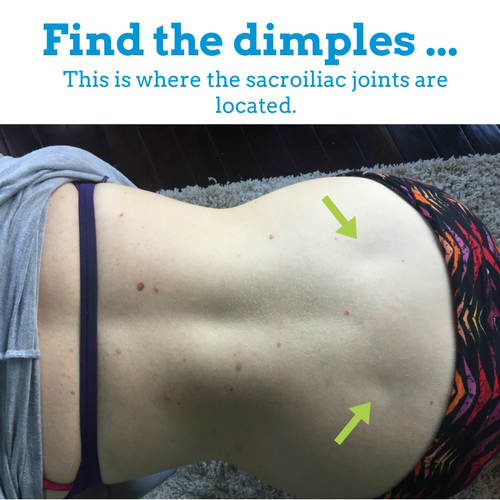
Cool.
Now, you may be nodding your head, thinking “This sounds just like me.”
If you’re about to start a handful of treatments on your pain from the chiropractor near you, feel free to give it a shot.
But if you’ve had your sacroiliac joint pain for more than a few months and treatment gives you temporary relief (lasting up to 48 hours), but always comes back (we call this the Irrelevant Pain Relief Window ), you may be wondering if there’s something else going on.
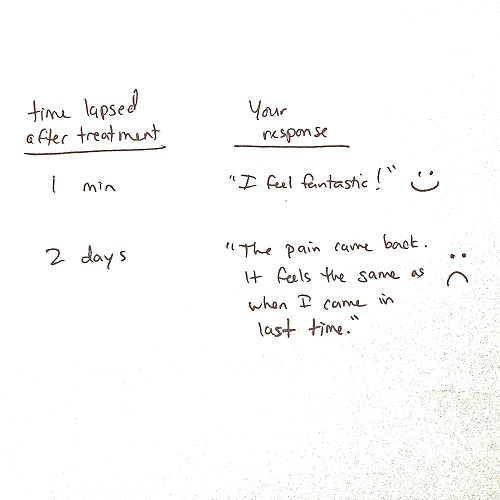 There’s a rule that’s meant to protect you from the Irrelevant Pain Relief Window.
There’s a rule that’s meant to protect you from the Irrelevant Pain Relief Window.
The 5 Visit Rule
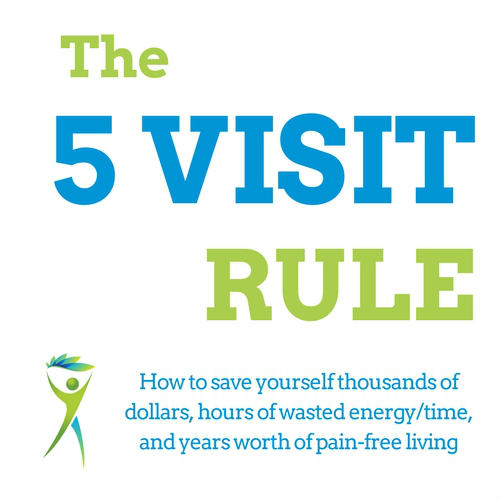
When I get together with my pain-fixing colleagues, we often talk about what effective treatment looks like.
What should you expect when seeing any musculoskeletal provider for your pain, no matter how long you’ve had it?
Your pain should show some sign of permanent and sustainable improvement within 5 visits of seeing any type of healthcare provider (including chiropractors, physical therapists, medical doctors, orthopedic doctors, acupuncturists, or massage therapists).
Those signs include:
- being located at one spot for 6 months and moving to a new location.
- reducing in intensity at least 10% or lowering from a 7/10 to a 6/10 that lasts after 48 hours have passed since your last treatment.
- coming later in an activity (like having to sit for 60 minutes before the pain sets in instead of 30 minutes).
If your pain hasn’t improved within 5 visits, your healthcare provider should now be:
- ordering imaging for your joint.
- decreasing the amount of activity you’ve been doing.
- identifying and offering proposed solutions for other factors (such as weight, medications, other diseases, sleep, stress) that may have been contributing to your pain.
If your healthcare provider hasn’t gotten you results and hasn’t changed the plan in 5 visits, it’s time to find another healthcare provider.
That’s the 5 Visit Rule.
If Natasha, a 40 year old single mom who travels all over New Jersey for work knew about the 5 Visit Rule, she wouldn’t have paid the NUCCA chiropractor she was seeing $5,000 for a treatment plan, seeing them for 40 treatments with 0% improvement.
She would have seen us at our office in Parsippany and seen a 15% improvement in her neck pain in 5 visits like she did just this week.
If it’s not sacroiliac joint pain, what else could it be?
The short answer is most commonly disc damage in your low back.
In the below image, notice all of the different colors. These are all of the places that disc damage can shoot pain.
The forest green color on his butt cheeks is where the sacroiliac joints are located.
You can confirm that you have some type of bulging disc pain by observing the following signs in yourself. Do you:
- wake up each morning with a stiff low back that goes away after 10-15 minutes?
- have low back pain when you pick up something off the ground or tie your shoes?
- get up from standing and have low back pain for 5 minutes, before it works itself out?
- experience excruciating pain in your low back for 2-10 day periods a couple of times per year, always to have your pain go away completely after that period?
The gold standard for knowing, with certainty, that you have disc pain, is when you get treated within 5 visits and your pain is surprisingly, noticeably, and gratefully 10, 20, maybe even 50% better!
Get Your Fake Sacroiliac Joint Pain Fixed!
Now that we’ve agreed that you probably have disc pain, it’s time to address it.
But first, a quick word about actual sacroiliac joint pain.
- It does exist (usually with degeneration and/or ligamentous instability).
- It usually involves trauma.
- It’s very rare.
I’ve been treating pain for 8 years and I can’t recall a single patient who came in saying that they had sacroiliac joint pain who was right.
Every one of them had pain that responded to disc treatment.
You can confirm that you have a disc problem by getting a friend to do the pencil test on you.
Once you’re ready to do something about it, find an Integrative Diagnosis provider near you to diagnose you correctly and to fix you.
If you’re close to Northern New Jersey, give us a call at our Parsippany office (862-205-4847) to schedule your diagnostic session today.
 What has your experience been with sacroiliac joint pain? Please share in the comments below.
What has your experience been with sacroiliac joint pain? Please share in the comments below.

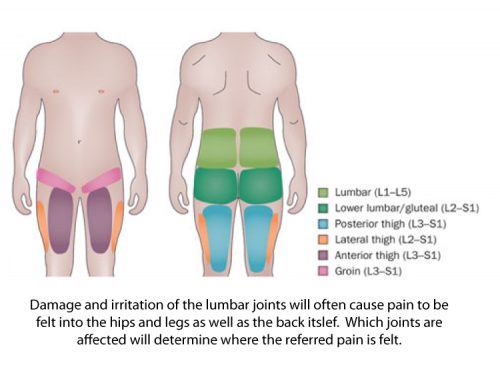
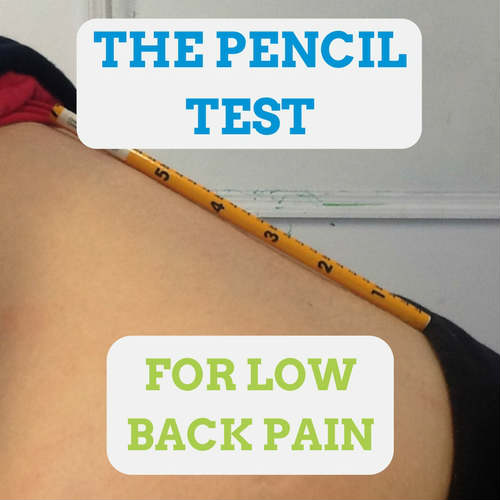
Shlomi medina
Posted at 22:32h, 02 MayHay
Iets bet that i have sij issues toghter with disc and facet issues as i self diagnosed by gogeling.
Dr. Chris
Posted at 16:39h, 03 MayOK..
Karen McCabe
Posted at 01:49h, 25 JulyAny good resources you know of, or providers in the CT area (closer to Hartford)? I’ve had what I thought was SI joint pain for 3 years now, I can’t go a day without wearing an SI belt. I get flare ups after too much exercise/certain types of physical activity. Any other ideas for me? I’ve partially given up hope. Thanks!
Dr. Chris
Posted at 12:29h, 25 JulyHi Karen, I believe we’re the closest chronic pain doctors to Hartford. We’re in North Jersey. Or is Boston closer? Have you had a lumbar MRI? It’s most often a disc problem.
Kurt mccarthy
Posted at 23:52h, 07 AugustWent into my orthopedic surgeons office suggesting SIJ pain. Xray and MRI with contrazy confirmed SIJ detoriotation. I was also I’m the Army so we are a bit different than standard civilians when it comes to wearing body armor and pushing our bodies to the max.
Dr. Chris
Posted at 11:01h, 08 AugustHow bad was the SIJ deteriorated? When do you feel pain? When does your pain go away? Any numbness or tingling down the legs?
Sanam sonal
Posted at 08:49h, 16 DecemberHi Kurt how u feeling? did you have surgery for your si joint?
Kenneth Allen
Posted at 16:26h, 22 FebruaryDr. Chris,
I am a 55 year old male. In August of 2020 I woke up one morning with excruciating pain in my right flank area. I have had 3 MRI of my lower back along with CT scans, x-rays, etc. I have had numerous injections in my lower back along with an eblasion of my L3,L4,L5 right side. My pain is constant in the SI area and becomes unbearable in my right hip, right butt cheek that radiates to the back of and side of my thigh when walking any distance. The pain worsens the more I walk. I also have pain and discomfort when sitting or riding in a vehicle and discomfort when lying on my right side. I feel it is from my SI joint!! What is your opinion? I go in today for my 2nd SI injection. The 1st injection helped with riding and driving but not with the walking.
Thank you
Dr. Chris
Posted at 17:13h, 22 FebruarySo sorry to hear this Ken. The SI Joint can not cause the flank pain. Discs do this, all day, every day. Can you find an adhesion release provider?
scott austin
Posted at 18:42h, 31 MarchDr. Chris,
Long story short heard snap in shower as I bent left and down pain across left si joint and low back. Over the next weeks pain progress to buttock area, then hip, then just about the knee to outside. Terrible pain cant sit, stand for long, or walk for long. Had injection in SI joint maaybe some improvement. Injection in l5 root nothing. MRI and xray are clean your thoughts? Chropractor baffled? I also get tingling on around the left knee area after about 5 seconds standing. Laying down all pain gone.
Thanks
Dr. Chris
Posted at 19:46h, 31 MarchSounds like a disc problem, especially because you have numbness/tingling down leg. Doesn’t matter that a shot didn’t work. The disc is still overloaded. You need to unload the discs. best way to do that is adhesion release.
raymond Scott austin
Posted at 21:22h, 04 Maythanks Dr. Chris I can now sit longer put pain right above the belt line when getting up from sitting around that si joint. What do you mean by adhesion release? How do I unload the disc if you think that is what it is? Thanks
Dr. Chris
Posted at 12:27h, 01 JuneSit according to Sit Slide Lean Rule (google it at barefootrehab.com).
You live in Austin? Closest adhesion provider is probably st louis if it’s bad enough
Katherine Schwenkner
Posted at 17:53h, 06 JulyHi Dr Chris. I’m not sure which direction to go now. I have pain in low back especially on left side, and pain in butt and down back of thigh and outer side of thigh. Neuropathy in both feet. I got a lumbar spine mri and saw both a spine doctor and a hip doctor a couple weeks ago. Spine doctor told me spine has no nerve compression. Hip doctor told me the hip looks good. I told him spine doctor said I might have piriformis syndrome. He told me he didn’t think so and just to continue my pt, chiropractor and seeing my pain management doctor. I said something and he said are you telling me or asking me. I left there crying. All my pain started in 2015. I have had several nerve decompression surgeries on my feet..still awful continuous pain in feet. I just had a spinal cord stimulator surgery in Nov 21. It’s not helping. Do you have any suggestions? Thank you Kathy.
Dr. Chris
Posted at 19:02h, 06 JulySo sorry for your struggles Kathy. Unfortunatley we see this alot. This sounds a lot like a primary lumbar spine problem. Your outer(lateral) thigh pain can NOT be piriformis syndrome or the sciatic nerve. The low back can explain the back of thigh, outer thigh and feet. That’s one problem or what we call a smoking gun. Where do you live? I’ll see if there’s an adhesion specialist near you.